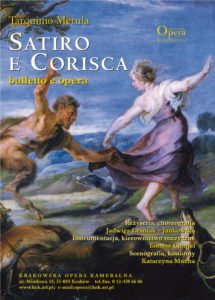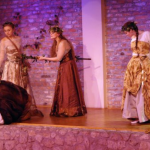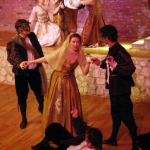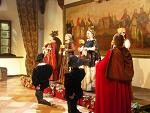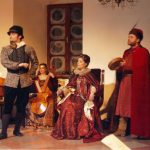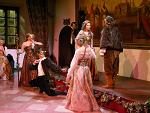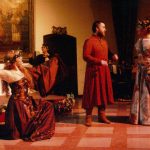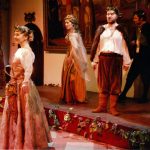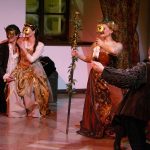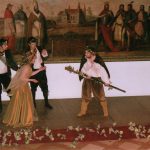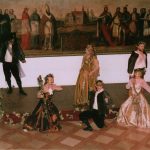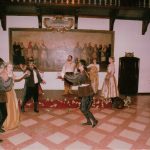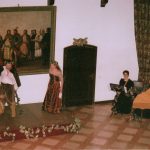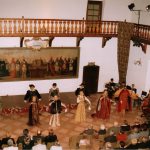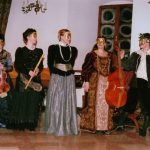Credits
Script, Direction, Choreography – Jadwiga Leśniak-Jankowska
Scenography, costumes – Katarzyna Mucha
Satiro – Paweł Popowicz (baryton)
Corisca – Anna Krawczyk (sopran)
Courtiers of King Zygmunt III vase:
Martyna Malcharek, Anna Warchał, Marta Filipowska,
Paweł Izdebski, Jakub Krawczyk (PWST), Piotr Malaga
The Old Instruments Orchestra of the Krakow Chamber Opera
Flute traverso – Monika Czyżewska
Baroque violin – Małgorzata Sopel
Viola da gamba – Anna Szelińska-Mikus
Spinet – Anna Huszczo
Photos
Zamek Królewski w Niepołomicach
fot.Paweł Zechenter
Reviews
The world of old tapestries
The historical instruments gently caress the ears. Four pairs of young, good-looking people dance playfully. Hops, bows, dignified promenades and quick chases after the partner are all part of a lovers’ game. Everything’s clear, but nothing’s blatant.
One can easily lose track of time during such play. And time indeed flows in a much slower pace than the one we’re used to. People living at the turn of 16th and 17th centuries were deeply aware of the briefness and frailty of human life. Maybe, paradoxically, that is why those who could afford it indulged in all kinds of entertainment, primarily music, dance, masquerades and finally opera – the combination of all those genres.
Watching the Saturday spectacle, which combined ballet and opera, made me ponder upon the artistic tastes of our ancestors. I realized how few people remember that the royal Polish court of Vasa has been – alongside the Italian courts of the time – place where European opera has taken shape and developed further.
Krakow Chamber Opera has staged its spectacle on the stage of the El-Jot theatre. This time they have revisited a play by Tarquinio Merula, an Italian composer living on the court of Sigismund III Vasa. A little duet tells a story of a failed courtship of beautiful but unfaithful Corisca by a satyr. The original Polish listener had a possibility to get acquainted with the latest innovations of the Italian musical theatre. Jadwiga Leśniak-Jankowska – script writer, director and choreographer – embellished the show with instrumental pieces by Merula and Polish late Renaissance/early Baroque dances. The resulting spectacle has been named ‘A carnival masquerade at the royal court’.
A chamber spectacle, fragile as some delicate trinket, is filed to the last detail. Beautiful costumes created by Katarzyna Mucha are modelled on the garments from the historical paintings. The young performers look splendid wearing them – they feel at ease in the convention,of the period, as if they had just stepped out of one of the tapestries hanging on the wall. A small musical ensemble playing historical instruments did not deviate from the score even once.
The main players, Anna Krawczyk and Maciej Michalik, not only were amusing on stage but also successfully coped with the challenging musical recitative – especially the melodic and harmonious shifts which may sound peculiar to modern listener. There were still a few moments where actors got carried away by the heated argument onstage, their expressiveness overpowering vocal accuracy. It is understandable, though, given the atmosphere of the premiere.
The musical spectacles staged by Jadwiga Leśniak-Jankowska in her own theatre El-Jot have a special place on the theatrical map of Krakow. They are rooted in the past, slow-paced, not dazzling with flamboyance – yet they find their devoted audience. It would seem that the need for loudness and obscenity is not that prevalent today after all. More people seem to crave the subtle charm of the show, perfection and elegance of the performance. Everyone who experiences similar needs should definitely pay a visit to the cellars at Miodowa St.
Anna Woźniakowska
Dziennik Polski
July 27th, 2006
* * * * * * * *
The premiere at Niepołomice Royal Castle
Charming, subtle and amusing
‘Satiro e Corisca’ by Krakow Chamber Opera
After 380 years ‘Satiro e Corisca’ by Tarquinio Merula is debuting again in the royal castle halls. The only difference is that originally it has been staged in the Warsaw royal castle, at the court of king Sigismundus III Vasa, and recently the play visited the Niepołomice castle.
Those were the words of Wacław Jankowski, the managing and artistic director of Krakow Chamber Opera, before the Friday premiere of this early Baroque opera buffa.
The audience was delighted by the opera’s artists. The musical spectacle was enriched by courtly ballet and historical dances. It captivates the viewer with its subtlety, airiness and charm of the early Baroque music and the courtly dances which most likely accompanied the mask balls. The staging is well-thought-out and not only amuses, but also bewitches the viewer with the choreographic precision of every single gesture or dance routine. Almost every scene is stopped somewhere in the middle, as if it was a celuloid frame. This allows to savour not only the musical, but also the visual side of the spectacle.
It is a humorous tale, a satire on female deviousness which tells the story of a nymph named Corisca who strings along a certain satyr. It is also the most innovative work by Italian composer and organist, Tarquinio Merula. He has composed the piece in Warsaw, at the beginning of 17th c. Merula has been one of the greatest Italian musicians who have performed in the Vasa royal ensemble.
Krakow Chamber Opera is going to stage ‘Satiro e Corisca’ next Saturday (September 25th), at 7 PM, on their home stage at Miodowa St. 15. The premiere at the Royal Castle in Niepołomice has been yet another enterprise of this music scene, a part of the ‘Opera meetings at the castle’ cycle. It was possible due to the artistic cooperation with Niepołomice municipality.
Mayor of Niepołomice, Stanisław Kracik, has taken honorary patronage of the event.
Wanda Ryszkiewicz
Dziennik Polski
February 20th, 2006
* * * * * * * *
A courtly Mardi Gras
‘Satiro e Corisca’, directed by Jadwiga Leśniak-Jankowska in Krakow Chamber Opera.
Reviewed by Monika Partyk in ‘Ruch Muzyczny’.
Of all the works composed at the beginning of the 17th century for the newly established opera stage at the royal castle in Warsaw only one has been preserved to this day: ‘Satiro e Corisca, dialogo musicale a due roci’ by Tarquinio Merula. One of its two remaining copies is in the custody of Jagiellonian University. The Krakow Chamber Opera, established in May 2005, has decided to stage this largely forgotten play at their headquarters, at El-Jot theatre in the Kazimierz district. The Krakow premiere has taken place on 25th of February, but it has been preceded by the staging at Niepołomice Royal Castle. The Krakow Chamber Opera, the missing piece in the musical and theatrical endeavours of the El-Jot theatre, would like specialize in the historical music. Beautifully designed interiors with an underground stage in an amphitheatrical setting create a fitting space for such projects.
‘Dialog Satiro e Corisca’ was written in 1626 in Warsaw on the Vasa court. It was an innovative piece, not only in Poland but on the European scale as well. It fully deserved the name ‘nuova’, given by composer himself. The most prominently innovative elements are the way recitative parts are being handled and the boldness of harmony. The text has been derived from the pastoral tragicomedy ‘Pastorfido’ by Giovanni Battista Guarini (act two, scene six). Its poetic language glitters with humour, fierceness and verbal swordplay. The wit of the author aims to ridicule many different things – female inconsistency and deviousness personified by nymph Corisca, as well as the futile anger of the rejected lover in the character of Satyr. The lengthy diapason of feelings, ranging from anger and mockery to love, as well as the exquisite poetic construction, are masterfully painted with music. Recitative, which is the only mean of expression in this composition, is far less crude than the one employed by the Florentine Camerata. It presents the text’s expressive values and brings out its construction at the same time. The exclamative hendecasyllables are accentuated by frequent leaps, each of them the length of the so-called ‘intervali falsi’ (false intervals). Those characteristics, combined with irregular pauses in each verse, must have been perceived as an utter novelty by the original listeners. Merula was surely aware of the fact, since he wrote in the preface/dedication that ‘it is Satyr’s music and not everyone is able to acknowledge its harmonious sound’.
The staging by Krakow Chamber Opera is a spectacle combining opera and ballet presented under the title ‘A Carnival Masquerade at the Royal Court’. The script writer, director, choreographer and one of the founders of the Chamber Opera, Jadwiga Leśniak-Jankowska, decided to draw on the tradition of florentine carnival, which combined dance, play and stage production. That is why the spectacle features not only the original play, but also instrumental pieces by Merula, ballet music by Sigismondo d’India and the historical dances from the Italian and Polish courts. All those additional elements combined into a lengthy introduction. It turned out to be a proving ground for the courtly ballet dancers – three pairs and the eponymous couple. The beautiful choreography, faithful to the historical tradition, showcased the distinct character of each dance. The presented Polish traditional dances were the ‘czapkowy’ (hat) dance, the ‘witany’ (welcome) dance, the ‘goniony’ (chasing) dance, and finally ‘suieczkowy’ and ‘faworytny’ dances. The foreign repertoire included pavanilla, pavane and gaillante. Ballet also played a vital role in the main part of the spectacle, a dialogue between Satyr and Corisca – it became an integral part of the story. The dancers were quite often becoming mimes, and their expressive movement has been building the comic quality of the situation onstage – just to mention the taunts aimed at Satyr, already enraged by Corisca’s intrigues. The accompanying laughter which grows as the play progresses also seems to be a rather clever device.
A double applause goes out to the pair od fingers: Anna Krawczyk – a strong, vibrant, bright soprano with a silvery timbre – and Maciej Michalik – a smooth bass with a warm pitch. They have displayed a great sense of musical style, but also extraordinary acting skills, which were noticeable both in their play and the expression of their voices. The musical ensemble conducted by Tomasz Chmiel (who was also responsible for the orchestration), consisting of traverso flute, baroque violin, viola da gamba and spinet, did really well. The most spectacular element of the whole spectacle, though, were the costumes inspired by the paintings of the old masters kept in Polish collections of art. They were the creation of a young seamstress and costume designer, Katarzyna Mucha. Stylish, majestic and charming at the same time, made of rich fabrics, pleasing to the eye – they adorned not only the protagonists and ballet dancers, but the musicians too. While the courtly fashion has been chosen for the dancing parts, a pastoral look has accompanied the recitatives. An ingenious design of the Satyr costume included a distinctive pelt cape and a caduceus entwined with grapevine. One of the crucial elements of the costumes were, as befits a carnival masquerade, golden masks, which were ‘played out’ in many different ways. In contrast to the lavish costumes, the scenography was restrained to the grapevines crawling over the scene with the addition of small curtains hanging here and there. In Niepołomice on the other hand, the royal chambers provided a fitting scenery with some beautiful tapestries hanging on the background walls.
The Florentine carnival was meant to entertain – but in style, teach – however discreetly, make you laugh – but without any vice. That is exactly how this spectacle feels like: allegorical, subtle and warm. It is also full of understatements – after all, it is a time when the players at the ball welcome each other with words: “Good morning, Lady Mask”. It is a tale of the deceptiveness of love, in which Satyr – certain that he will win over his beloved, expecting ‘the pleasures of love’ promised in pavanilla – is left in the end only with Corisca’s curly wig. Although the range of feelings tormenting the characters is vast, they do not extend beyond good manners – which allegedly was the case with the author of the play, who has been expelled from his post in Bergamo due to the ‘immoral conduct’. What more can one wish for during the Mardi Gras?
‘Mardi Gras in courtly fashion’
Monika Partyk
‘Ruch Muzyczny’, issue 7
April 7th, 2006

